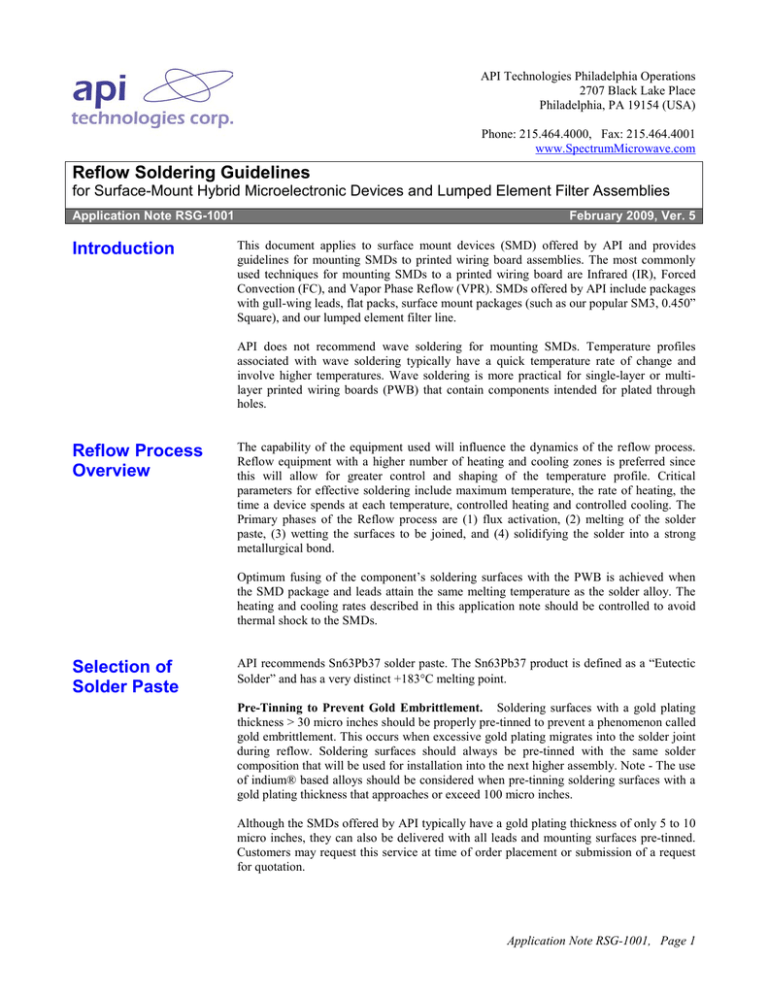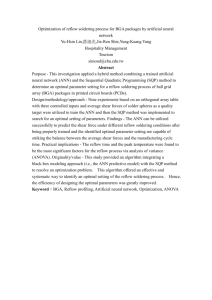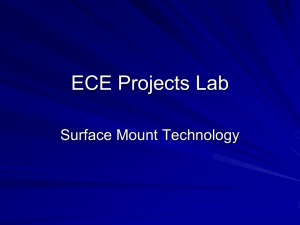Reflow Soldering Guidelines for Surface
advertisement

API Technologies Philadelphia Operations 2707 Black Lake Place Philadelphia, PA 19154 (USA) Phone: 215.464.4000, Fax: 215.464.4001 www.SpectrumMicrowave.com Reflow Soldering Guidelines for Surface-Mount Hybrid Microelectronic Devices and Lumped Element Filter Assemblies Application Note RSG-1001 Introduction February 2009, Ver. 5 This document applies to surface mount devices (SMD) offered by API and provides guidelines for mounting SMDs to printed wiring board assemblies. The most commonly used techniques for mounting SMDs to a printed wiring board are Infrared (IR), Forced Convection (FC), and Vapor Phase Reflow (VPR). SMDs offered by API include packages with gull-wing leads, flat packs, surface mount packages (such as our popular SM3, 0.450” Square), and our lumped element filter line. API does not recommend wave soldering for mounting SMDs. Temperature profiles associated with wave soldering typically have a quick temperature rate of change and involve higher temperatures. Wave soldering is more practical for single-layer or multilayer printed wiring boards (PWB) that contain components intended for plated through holes. Reflow Process Overview The capability of the equipment used will influence the dynamics of the reflow process. Reflow equipment with a higher number of heating and cooling zones is preferred since this will allow for greater control and shaping of the temperature profile. Critical parameters for effective soldering include maximum temperature, the rate of heating, the time a device spends at each temperature, controlled heating and controlled cooling. The Primary phases of the Reflow process are (1) flux activation, (2) melting of the solder paste, (3) wetting the surfaces to be joined, and (4) solidifying the solder into a strong metallurgical bond. Optimum fusing of the component’s soldering surfaces with the PWB is achieved when the SMD package and leads attain the same melting temperature as the solder alloy. The heating and cooling rates described in this application note should be controlled to avoid thermal shock to the SMDs. Selection of Solder Paste API recommends Sn63Pb37 solder paste. The Sn63Pb37 product is defined as a “Eutectic Solder” and has a very distinct +183°C melting point. Pre-Tinning to Prevent Gold Embrittlement. Soldering surfaces with a gold plating thickness > 30 micro inches should be properly pre-tinned to prevent a phenomenon called gold embrittlement. This occurs when excessive gold plating migrates into the solder joint during reflow. Soldering surfaces should always be pre-tinned with the same solder composition that will be used for installation into the next higher assembly. Note - The use of indium® based alloys should be considered when pre-tinning soldering surfaces with a gold plating thickness that approaches or exceed 100 micro inches. Although the SMDs offered by API typically have a gold plating thickness of only 5 to 10 micro inches, they can also be delivered with all leads and mounting surfaces pre-tinned. Customers may request this service at time of order placement or submission of a request for quotation. Application Note RSG-1001, Page 1 Selection of Solder Stencil A solder stencil is recommended for applying the optimal amount of solder paste onto the printed wiring board. The amount and thickness will directly affect the quality of the joint and is critical to ensure a proper solder connection between the base of the SMD package and the PWB. API suggests a 0.004 to 0.007 inch thick stainless steel stencil. Brass stencils may also be used. Because brass will wear quicker, the screen thickness will need to be measured periodically. The stencil openings should be the same size (1:1 registration) as the PWB footprint pads and/or ground plane areas for the SMD package. However, if fine pitch components on the same board require a thinner stencil, aperture modification may be necessary. Development of Solder Reflow Profile Although solder reflow guidelines are provided as part of this application note, the customer is ultimately responsible for determining the specific settings and process controls that are appropriate for the reflow equipment that will be used. Additionally, solder paste manufacturers typically have profile recommendations specific to their paste formulations; these should also be consulted to determine the best profile for your process. Thermocouple Placement. The outside edges and corners of a printed wiring board tend to heat up somewhat faster than center areas of the board. Additionally, SMD components of lesser thermal mass tend to heat up more quickly than SMDs of greater thermal mass. As a minimum, API suggests placing a thermocouple toward the edge or corner of the printed wiring board, another on an SMD component of small mass, and another in the center of a SMD component with the largest mass. Additional thermocouples may be placed in other areas of interest. Initial Pre-Heat and Pre-Soak Stages (See Figure-1) Initial Pre-Heat Stage. PWBs should be preheated prior to solder reflow. During the pre-heat stage, the solder paste begins to dry as volatile ingredients are allowed to evaporate. The initial pre-heat stage takes place during the first 90 seconds of the reflow profile as the temperature is slowly increased from room ambient conditions to approximately +155°C. Flux Activation and Pre-Heat Soak Stage. Following the initial pre-heat stage, the temperature is gradually increased to +183°C over a period of approximately 90 seconds so the flux in the solder paste can clean the bonding surfaces properly. During the pre-heat soak (also know as the flux activation stage), the solder paste and soldering surfaces should be roughly the same temperature. Solder Reflow Stage (See Figure-1) Ramp Up. The PWB now enters the solder reflow stage. Over a period of 30 seconds, the temperature should be increased to the appropriate peak reflow temperature shown below. Depending on package dimensions, exposure time at peak temperature should be minimized (re. J-STD-020A). Peak Reflow Temperatures: • +220°C to +225°C for IR and FC Reflow Systems. • +215°C to +220°C for most VPR Systems. Ramp Down. The reflow stage is completed as the temperature is reduced to +183°C (the original melting point of the solder paste) over a period of approximately 30 seconds. Caution - Over baking the solder paste and/or exceeding the glass transition temperature of the FR-4 printed wiring board material should be avoided. Application Note RSG-1001, Page 2 Cooling Stage (See Figure-1) The profile is completed as the temperature is gradually reduced from +183°C to < +40°C over a period of approximately 3 minutes. The gradual cooling of the printed wiring board after reflow is important. It is during this period that the molten solder solidifies to form a strong joint fillet. FIGURE-1 Suggested Solder Paste Reflow Profile for SMDs and Lumped Element Filters offered by API • Thermal Profiling is a key element in the assembly of PWBs both to determine process machine settings and to verify process consistency. • When designing the best profile for the reflow equipment that will be used, API suggests you consult your solder paste supplier and also review the specifications for all components that will be mounted on the PCB. Application Note RSG-1001, Page 3 Tips For Optimizing The Reflow Process • • • • • • • Other Precautions • • Preheat and Temperature Soak. Always preheat the PWB as part of the reflow profile. Failure to do so can cause excessive thermal shock and stress that can results in damage to the device. Heating and Cooling Zones. Reflow ovens providing more heating/cooling zones are better because they provide greater control and shaping of the temperature profile. Reflow Heating Elements. Use a reflow oven that has more heating elements in both its floor and ceiling to minimize temperature variations, to deliver precise temperature, and to provide the necessary heat in areas of the board that might be shielded. Reflow Oven Belt Variations. Variation can exist across the width of an oven belt. It is best to characterize and run a sample PWB in the same relative position across the oven belt. Monitor temperature variations particularly at the edges of the PWB and in areas where the SMDs will be soldered. Reflow Validation. Validate the reflow process by thermal profiling and evaluating the finished solder joints. This may be accomplished by visual inspection, by electrical testing, and when necessary by Cross Section or X-Ray. Analyzing the solder joints may reveal specific ways to improve the reflow process. Adjustment of Reflow Duration. Adjust the reflow duration to create good solder joints without raising the SMD body temperature beyond the ‘Peak Reflow Temperatures’ specified herein. Cooling Guidelines. After reflow soldering has been accomplished, the devices should be allowed to cool naturally for at least 3 minutes. Gradual cooling is important as the use of forced cooling will increase the temperature gradient and may result is latent failure due to mechanical stress. Avoid any mechanical stress or shock during the cooling portion of the reflow profile. Handling Precaution. Although API uses industry-standard materials and manufacturing processes, SMDs should be packaged, stored and handled carefully to prevent any lead damage or deformation. Such defects can prevent flush placement with the PWB footprint and can also allow for unwanted solder shorts or bridging. Cleaning Precaution. SMDs (and PWBs containing SMDs) must never be exposed to Ultrasonic Vibrations during solvent cleaning or vapor degreasing to remove flux. Ultrasonic vibrations will damage the internal bond wire connections and cause device failure. < END > Originator: Dan Mieczkowski QA Manager, API Philadelphia Copyright 2004 Spectrum Microwave Philadelphia Operations. All rights reserved. Information contained herein is based on data believed to be accurate and reliable, and is offered by Spectrum Microwave at no charge. Additionally, Spectrum Microwave assumes no responsibility for its use; or for any infringements of patents or other rights of third parties which may result from its use. No warranty is expressed or implied regarding the accuracy of this data. Liability is expressly disclaimed for any loss or injury arising out of the use of the information herein. Spectrum Microwave reserves the right to revise the information herein at any time and without notice. Accordingly, users of this Application Note are encouraged to contact a Spectrum Microwave Sales Representative to confirm the current revision of this document. API, Philadelphia Operations An ISO 9001:2000 Company Certificate No. C2009-01318 Expiration Date: November 12, 2010 Application Note RSG-1001, Page 4



